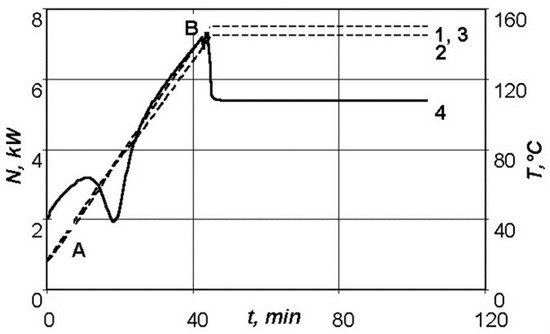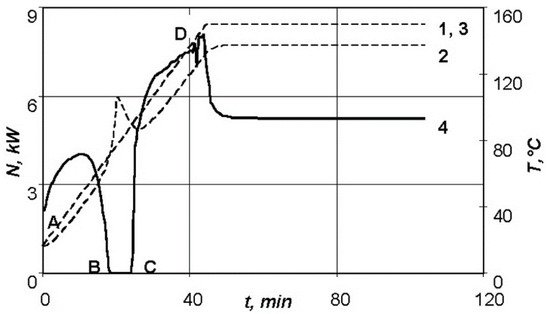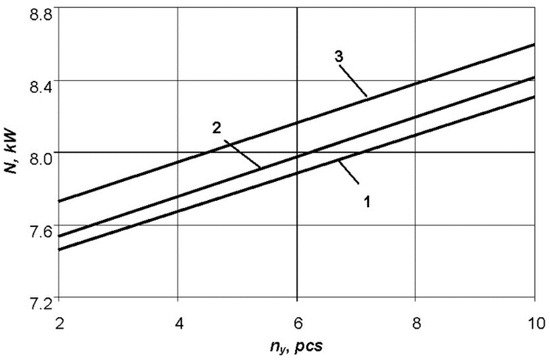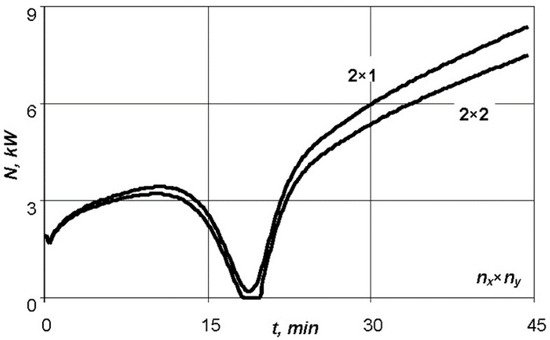1000/1000
Hot
Most Recent

The shipbuilding industry, engine manufacturing, aviation, rocket and space technology are promising fields of application for polymeric composite materials. Shape-generating moulding tools with internal heating are used for the creation of a more economically viable method of moulding of internally heated composite structures. The use of a fine-fibered resistive structure in the heated tools allows implementation of effective heating of the composite and elimination of the need for expensive and energy-intensive heating equipment.
At the present time, composite materials based on ultrathin carbon, glass, organic and other types of fibres in combination with polymeric binders are widely used in various branches of technology[1][2][3][4], such as general construction, bridge engineering, road infrastructure, transport, agricultural machinery, the power sector, biomedicine, and petro-chemistry[5][6][7][9][8][10]. The shipbuilding industry, engine manufacturing, aviation, rocket and space technology are the most promising fields of application of polymeric composite materials[11][12]. High specific strength and stiffness, as well as a number of other unique properties of the composites, which allow the implementation of special qualities in the structure, are in demand in these fields[13][14].
One of the most rational methods of repair of typical operational defects (cracks, penetration defects of skin, delaminations) in metal and composite panel constructions is the installation of patches made of polymeric composite materials[16][15]. The high physical and mechanical properties of the composites and the significant advantages of the adhesive joints over mechanical ones, determine the successful use of patches made of polymeric composite materials for the repair of both polymeric and metal structures of various applications[17][18][19]. Because the need for repair of structures in the future will continue to grow, increase in the efficiency of repair processes is no less important than improvement of the methods of designing of new structures[20][21][22].
Moulding of products of polymeric composite materials is performed, as a rule, with the use of heaters (furnaces or autoclaves). The efficiency of any heating method is determined by the ratio of produced and transferred heat, therefore the introduction of contact heaters in the manufacturing of composites is an urgent task [23][24]. It allows reduction of the time and costs for the production of composite structures. Now there are several areas in the development of heating equipment, which provide reduced energy consumption in the process of creation and reconditioning repair of composite structures. In order to implement new methods of composite structure moulding, binder compositions cured by ultraviolet radiation or another type of radiation have been developed, as well as heating complexes where the shaping surface of the tools is an integrated part [25]. However, such complexes are characterized, apart from high cost, by the great complexity of production, operation, and maintenance; therefore, they do not find wide industrial application.
For the creation of a more economically viable method for moulding of composite structures, heated moulding tools are developed, to which the heat is supplied by convective or contact heat transfer. The use of resistive blocks in the heated tools allows implementation of efficient heating of the polymeric composite materials without significant changes to the tool design [26]. The heating units can be manufactured on the basis of the fine-fibered resistive structure or plates/small cores. The main disadvantage of plates and units with a core is the gap occurring in the process of unit installation; the resulting temperature difference can be compensated only by a sufficient thickness of the shaping surface of the tool. Resistive blocks based on fine-fibered resistive structures are the only units, which allow implementation of the uniformity of the temperature field on the shaping surface, when the resistive blocks are installed with a gap equal to the pitch of the laying of the resistive thread [27].
Authors of the paper[28] propose a cure of the binder by applying an electric current to the carbon fibre composite part. It was shown that the electrical conductivity of carbon fibre allows individual fibres to act as heating elements. As a result, there is a large number of internal heating elements throughout the composite part. The degree of curing was compared to composites cured in the traditional way. The three-point bending test was used to determine the flexural strength and modulus of elasticity. The results showed that the proposed technology provided polymeric composite material parameters on a level with autoclave production.
A method of direct resistive heating of the composite workpiece for curing was proposed in[29]. The heat problem was solved numerically by the finite element method. In this case, the heat conduction equation and kinetics of the binder curing reaction in the composite workpiece were modelled. Since the resistivity of materials is temperature dependent, a system with nonlinear relationship was developed. Comparison of the obtained results with experimental data showed satisfactory repeatability.
The paper[30] deals with the study of the method of self-resistive electric heating for the rapid moulding of parts of carbon fibre reinforced plastic. For the generation of heat and direct curing of the bind
er, the use of the electric current passing through the carbon fibre was proposed. A self-resistive tool with an automatic temperature controller was developed. This study presents the results of experiments on the moulding of composite parts with the use of the developed equipment. The degree of curing of various specimens was characterized, and their cross-sectional geometry and porosity evaluated. On the basis of the experimental results, the behaviour of the heat transfer of various processes was analysed.
To reduce the autoclave costs, the use of a self-heating composite mould made of carbon fibre composite was proposed in . It was suggested to use the reinforced carbon fibre composite shaping surface as the heating elements. The paper shows that due to the very low coefficient of thermal expansion of carbon fibre composite, this material is an excellent choice for the manufacturing of such moulds. The predicted uniformity of the temperature field was confirmed experimentally using thermocouples and an infrared camera.
A self-heating composite tool with built-in resistive layer was developed in[31][32] . It was shown that this layer evenly distributes the heat in close proximity to the surfaces of the part while ensuring a high level of mechanical characteristics of the polymeric composite materials. Finite element modelling of heat transfer confirmed that the tool configuration and selected heating elements provide sufficient heat uniformity to achieve the desired binder curing. Nevertheless, the paper indicates the necessity to solve the problem of choosing the optimal position of the resistive layer, as well as further testing to verify and calibrate the system to obtain the the optimal degree of binder curing.
The method for calculation of the heated tools providing rigidity and service life, with the heating layer based on the resistive blocks, was proposed in[33]. The parameters of the heating system (material of the heating elements, their geometry, and material of the insulating system) and the diagram of its connection were determined from the condition of securing the required heating mode. The heating was controlled by changing the current strength during the process, determined from the solution of the heat conduction problem, taking into account the exothermic effect of the curing reaction and conditions of heat transfer on the surface.
The thermodynamic model of unsteady heat transfer during moulding of the polymeric composite material in heated tools was developed in[34]. The model allowed the temperature distribution over the thickness of the system under study to be obtained, the influence of the exothermic effect of the binder curing reaction to be evaluated, and the required power of the heating system to be determined. The disadvantage of this paper is the assumption that the model does not take into account the ribbing of the lower surface of the moulding tools.
As shown from the review and analysis of the problem, the possibility of out-of-autoclave production of the composite parts with the use of moulding tools with internal heating has now been substantiated. It eliminates the need for the expensive and energy-intensive heating equipment. For the improvement of the preproduction activity through a reasonable choice of the design of the moulding tools, it is necessary to develop an integrated solution, which allows reducing costs and shortening the production cycle. Therefore, the aim of the paper was to reduce energy consumption for internally heated moulding tools by choosing the optimal parameters of the resistive layer.
To achieve this purpose, it was necessary to solve the tasks below:


| Heating Rate, °C/min | Required Power of Resistive Layer, kW | Energy Consumption, kW/h |
|---|---|---|
| 1 | 6.15 | 7.16 |
| 2 | 6.78 | 4.17 |
| 3 | 7.51 | 3.18 |
| 4 | 8.10 | 2.68 |
| 5 | 8.78 | 2.38 |
| 6 | 9.46 | 2.19 |
| 7 | 10.15 | 2.04 |
| 8 | 10.83 | 1.94 |
| Thickness of Lower Part of the Shaping Surface, mm | Required Power of the Heating System, kW | Energy Consumption, kW/h |
Required Power of the Heating System, kW |
Energy Consumption, kW/h |
Required Power of the Heating System, kW |
Energy Consumption, kW/h |
|---|---|---|---|---|---|---|
| Fiberglass | Aluminium Alloy | Steel | ||||
| 0.5 | 6.99 | 2.81 | 7.06 | 2.83 | 7.20 | 2.90 |
| 1 | 7.16 | 2.94 | 7.37 | 2.97 | 7.46 | 3.12 |
| 2 | 7.51 | 3.18 | 7.71 | 3.27 | 8.16 | 3.57 |
| 4 | 8.08 | 3.62 | 8.49 | 3.86 | 9.91 | 4.45 |
| 6 | 8.56 | 4.01 | 9.44 | 4.45 | 10.53 | 5.34 |
| 8 | 8.96 | 4.33 | 10.35 | 5.04 | 12.18 | 6.22 |
| 10 | 9.44 | 4.60 | 11.44 | 5.62 | 12.87 | 7.10 |

